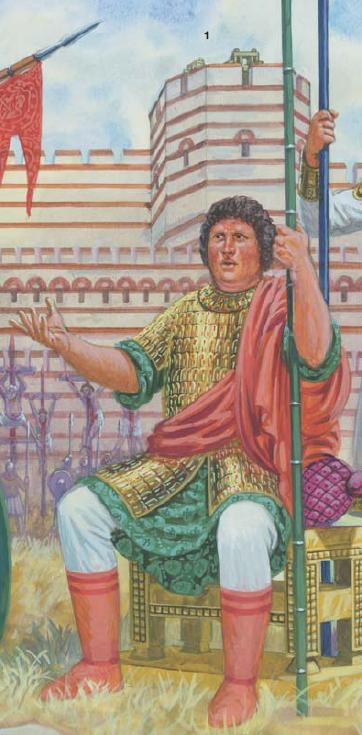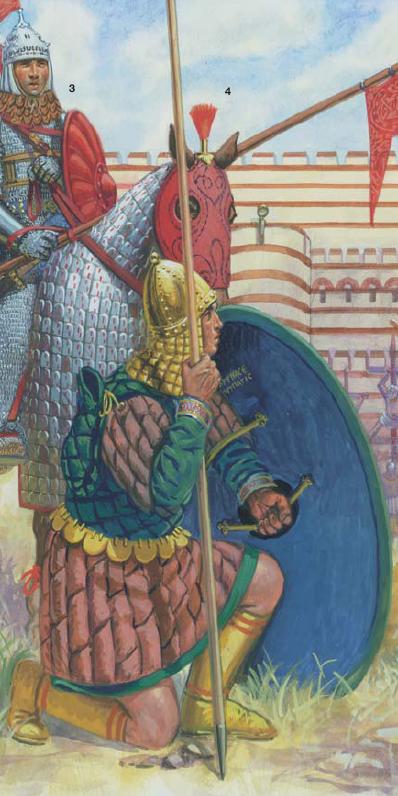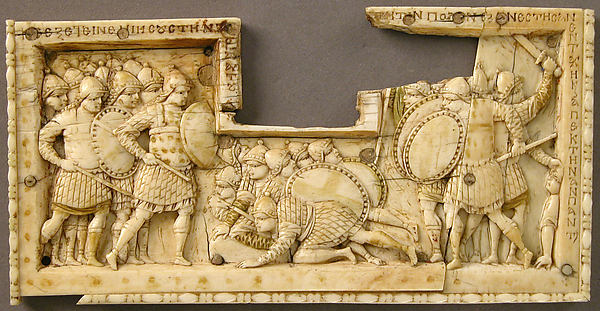
A larger image of the The Destruction of Ai, on this 10th Century Byzantine Casket.
 “And Joshua stretched out his hand toward the city and they rose up quickly and they slew all” (Joshua 8:18–19).
“And Joshua stretched out his hand toward the city and they rose up quickly and they slew all” (Joshua 8:18–19).Dimensions: 6.9 x 13.7 x 0.6 cm
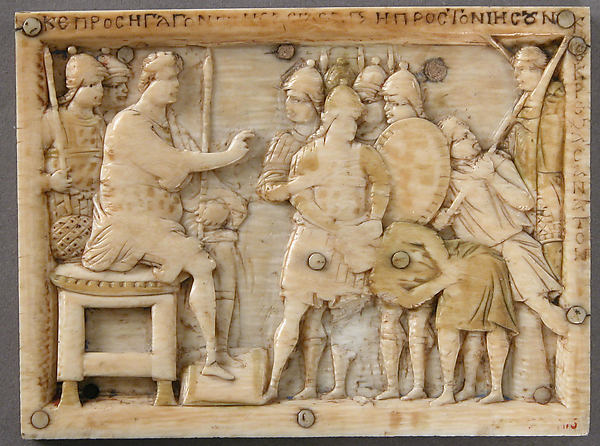
A larger image of the The Captive King of Ai, on this 10th Century Byzantine Casket.
 “And they brought the King of Ai to Joshua and they hanged him” (8:23, 29).
“And they brought the King of Ai to Joshua and they hanged him” (8:23, 29).Dimensions: 6.5 x 8.7 x 0.6 cm
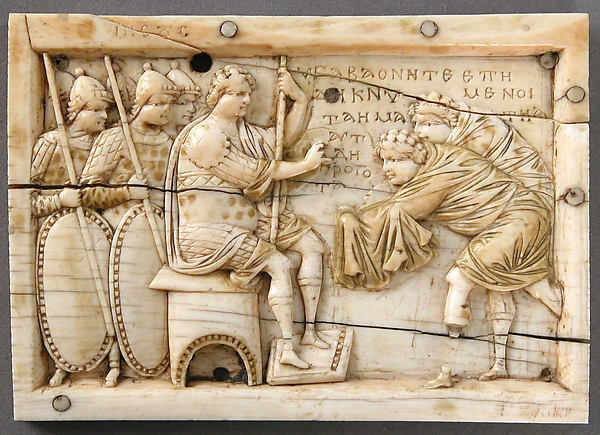
A larger image of the Emissaries from the Gibeonites, on this 10th Century Byzantine Casket.
 “The Gibeonites displaying their torn clothes” (9:13).
Joshua’s story was often invoked in the middle Byzantine period, when Byzantines identified themselves with God’s chosen people,
likening their own military victories and defeats to those of the ancient Hebrews.
“The Gibeonites displaying their torn clothes” (9:13).
Joshua’s story was often invoked in the middle Byzantine period, when Byzantines identified themselves with God’s chosen people,
likening their own military victories and defeats to those of the ancient Hebrews.Dimensions: 6.3 x 9 x 0.6 cm
Panels from an Ivory Casket with Scenes of the Story of Joshua
Date: 10th century
Geography: Made in Constantinople
Culture: Byzantine
Medium: Ivory, traces of polychromy
Classification: Ivories
Credit Line: Gift of J. Pierpont Morgan, 1917
Accession Numbers: 17.190.135a, 17.190.136a & 17.190.137a
Source: Metropolitan Museum of Art, New York
The three plaques and their borders ornamented with rosettes and medallion heads were once fastened to the wooden core of a box of the type called a rosette casket, of which about fifty examples survive.1
...
The carving of the plaques, in varying depths of relief, represents a technical tour de force; the clear articulation of forms and space and the realistic and accurate details are astonishing for a work of such small scale. Some elements are deeply undercut or carved in the round, and the backgrounds of the plaques are reduced to a translucent paper-thinness. The plaques can be closely associated in style and iconography with other ivories of the classicizing movement of the tenth century, the so-called Macedonian renaissance, but most specifically with an illuminated manuscript, the Joshua Roll, dating to about 950.2 In both roll and ivories there is a classical feeling for the structure of the body beneath plastically rendered drapery. The illusion of depth created through overlapping and through the subtle relief carving is comparable to the masterly juxtaposition of figures and settings and the delicate modeling in the roll. We can assume that a manuscript was used as a model for the ivories and that they were created in a work-shop in the imperial palace of the Byzantine emperors in Constantinople. The rosette caskets may have served as gifts or as luxury objects for display.3
In their abundant preservation of polychromy, the Joshua panels and their borders represent an important aspect of Byzantine ivories.4 Although some traces of green, blue, red, black, brown, and gold can be seen with the naked eye, the color scheme can be almost completely restored on the basis of microscopic analysis. All the pieces had bright blue backgrounds and red frames; red also occurs on the edges of tunics, on Joshua's mantle, on boots, and on the petals and backgrounds of rosettes. The garments of a number of figures were once a bright green, as were the borders of the shields and the legs of Joshua's throne. The armor and helmets and the edges of garments were gilded. Black accentuates the dotted pattern on the chair cushions and the eyes of all the figures and is also used for the inscriptions. Gold, blue, red, and green, sometimes in layers, appear in the medallions of the borders. The color scheme is thus comparable to that found in the sumptuous illuminated manuscripts of the period, such as the Paris Psalter, as well as in other precious, brilliantly colorful media such as enamels, icons, mosaics, and textiles. Pigment tests on the ivories reveal that the colors are lapis lazuli, vermilion, malachite, and gold, all of which were used for painting in the medieval period. On the basis of these pigment tests and studies of a group of one hundred Late Antique and Byzantine ivories, the great majority of which bore traces of color, the polychromy such as that found on the Joshua plaques is very likely to be original.5
CC
1. Goldschmidt and Weitzmann 1930, vol. 1, pp. 23-24.
2. Schapiro 1949, p. 173; Weitzmann 1948, p. 35.
3. Connor, "New Perspectives" 1991, pp. 108-10.
4. Ibid., pp. 105-8.
5. Connor, The Color of Ivory (forthcoming).
Source: The Glory of Byzantium : art and culture of the Middle Byzantine era, A.D. 843-1261 / edited by Helen C. Evans and William D. Wixom. Metmusem
OFFICERS AND SOLDIERS PREPARING FOR THE BULGARIAN SIEGE, AUGUST 913
